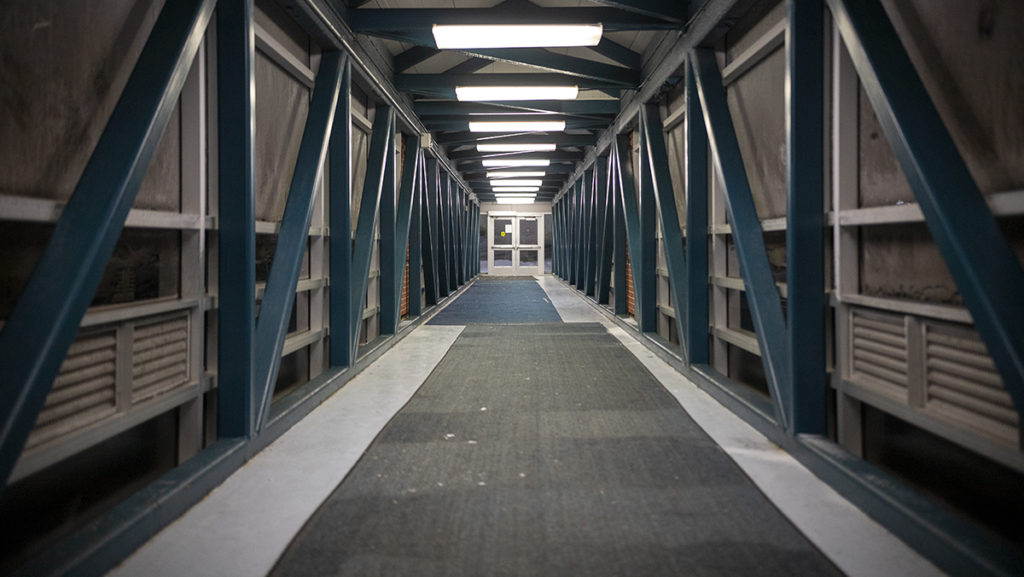Since Feb. 3, two separate swastikas have been found drawn inside buildings on the Ithaca College campus. The first swastika was found Feb. 3 drawn on the condensation of a window in Baker Walkway. The second swastika was found Feb. 8 on a poster in the James J. Whalen Center for Music. Both have active investigations –– one as a potential vandalism hate crime.
Following the discovery of the first swastika in Baker Walkway, Interim President La Jerne Cornish sent an email to the campus community condemning the symbol Feb 4. After the second swastika was found in Whalen, the Office of Public Safety and Emergency Management sent out an alert Feb. 8 to the campus community. The drawing had been scratched onto a poster in a practice room and is now under investigation as a vandalism hate crime, but the suspect is not known yet. Public Safety said the second swastika was reported in the afternoon of Feb. 8, but the incident occurred between the morning of Feb. 2 and 8. While it is unknown if the two incidents are connected, Baker Walkway connects Whalen and the Towers parking lot (J-Lot).
Junior Alexa Chalnick, a Jewish student at the college, found the first swastika when she was walking through Baker Walkway with her friend on Feb. 3.
“Immediately after seeing [the swastika] my heart dropped,” Chalnick said. “I got all hot and flushed and I said goodbye to my friend … so then I was alone, sort of just going back to Terraces, and I was crying. I was so upset. I could not understand why anyone would think that that was okay.”
Antisemitic and racist incidents are not new to the college. In April 2019, swastikas were found on the doors to dorm rooms. In 2019, a student wrote a commentary for The Ithacan saying they had found their mezuzah — a prayer scroll with Hebrew verses from the Torah — ripped from their door. According to previous reports by The Ithacan, in May 2013 someone found antisemitic graffiti and in April 2014 a swastika was drawn in a residential hall. In the 2015–16 academic year, two swastikas were drawn in East Tower. In December 2016, a report was made after an antisemitic slur was written in Bogart Hall.
Tom Dunn, director for the Office of Public Safety, said two swastikas were found in 2018, one in Terrace 9 and one in West Tower. Dunn said the most recent incident on Feb. 3 is the first reported image of a swastika since a 2019 report in Talcott Hall.
Dunn cannot comment on any details involving the two swastikas because both investigations are still open; however, Public Safety should be contacted at 617–274-3333 with any information regarding the incidents.
As a result, while all of these incidents are classified as aggravated harassment under New York State Law and are bias-related, not all of them are classified as Hate Crimes under the Clery Act.
Elyse Nepa, Clery Act and crime prevention coordinator for Public Safety, said there are many factors to consider when classifying a crime.
“That was one of the things we took into consideration last night, when we were making the determination to issue a public safety alert,” Nepa said. “Having two swastikas on our campus in a matter of a week is a cause for concern for the safety of the members of our community, mentally and physically.”
Dunn said safety measures in times like this include directing officer patrolling to a certain area when there is evidence to believe that it needs special attention.
Nepa also mentioned an event that had been planned before the recent swastika reports came to light. She said Public Safety is facilitating an emergency preparedness and response training in Muller chapel at 2 p.m. Feb. 11.
Freshman Rachel Lubell, a Jewish student, said in Fall 2021 someone had drawn a swastika on one of the doors in her dorm hall.
“At this point, I’ve become so numb to this kind of stuff because like, obviously it’s sad, but it’s become common,” Lubell said. “It doesn’t shock me anymore because it’s so deeply ingrained into our society and I think a lot of that has to do with lack of education.”
In a Feb. 8 interview before the second swastika was found, Lauren Goldberg, executive director of Hillel at Ithaca College and interim director for the Office of Religious and Spiritual Life, said the college’s swift condemnation of the drawing and antisemitism as a whole is the kind of leadership that allows for Jewish students to feel supported and seen. Goldberg said she felt widespread support from the entire campus community but witnessing acts of antisemitism, especially in one’s hometown, is always scary.
“Our people have suffered so much under what the symbol of a swastika stands for,” Goldberg said. “Imagine walking, you know, on a normal day, like to your class or to get a bite to eat and the feeling of just the wind being sucked out of you or like a punch in the gut.”
The incidents come during a time of rising antisemitic incidents throughout the Western world. The Anti-Defamation League found that 2020 was the third-highest year since 1979 for antisemitic incidents. On Jan. 22, Hillel and other religious groups held a gathering in the Bernie Milton Pavillion to mourn a hostage standoff at a synagogue in Colleyville, Texas.
Matt Price ’20 was part of Hillel all four years of his time at the college. He said he appreciates the college’s response to the swastikas but hopes results can come from their words. Price said he wants the person or people responsible to not only be disciplined but also counseled so they can understand the impact of their actions.
“For these symbols to pop up, especially in a place that I call my second home, Ithaca College, it’s just sad,” Price said. “It makes me upset, heartbroken, frustrated … I mean, [the swastika] last week was shocking, but [the swastika] this week was definitely shocking.”
Correction: In the original publication of this story, the Anti-Defamation League was written as “The American Defamation League.”









